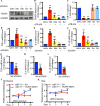MiR-31-5p regulates the neuroinflammatory response via TRAF6 in neuropathic pain
- PMID: 38267979
- PMCID: PMC10807213
- DOI: 10.1186/s13062-023-00434-1
MiR-31-5p regulates the neuroinflammatory response via TRAF6 in neuropathic pain
Abstract
Background: Neuropathic pain is chronic pain and has few effective control strategies. Studies have demonstrated that microRNAs have functions in neuropathic pain. However, no study has been conducted to demonstrate the role and mechanism of microRNA (miR)-31-5p in neuropathic pain. Accordingly, this study sought to determine the pathological role of miR-31-5p in chronic constriction injury (CCI) -induced neuropathic pain mouse models.
Methods: We used CCI surgery to establish mouse neuropathic pain model. Behavioral tests were performed to evaluate pain sensitivity of mice. Expressions of miR-31-5p and inflammatory cytokines in dorsal root ganglion (DRG) were examined by polymerase chain reaction. Animals or cells were received with/without miR-31-5p mimic or inhibitor to investigate its role in neuropathic pain. The mechanism of miR-31-5p was assayed using western blotting, immunofluorescence staining and dual-luciferase reporter assay.
Results: We found that CCI led to a significant decrease in miR-31-5p levels. Knockout of miR-31-5p and administration of miPEP31 exacerbated pain in C57BL/6 mice. Meanwhile, miR-31-5p overexpression increased the paw withdrawal threshold and latency. TRAF6 is one of the target gene of miR-31-5p, which can trigger a complex inflammatory response. TRAF6 was associated with pain and that reducing the DRG expression of TRAF6 could alleviate pain. In addition, miR-31-5p overexpression inhibited the TRAF6 expression and reduced the neuroinflammatory response.
Conclusions: All the results reveal that miR-31-5p could potentially alleviate pain in CCI mouse models by inhibiting the TRAF6 mediated neuroinflammatory response. MiR-31-5p upregulation is highlighted here as new target for CCI treatment.
Keywords: Neuroinflammatory response; Neuropathic pain; TRAF6; miR-31-5p.
© 2024. The Author(s).
Conflict of interest statement
The authors declare that they have no competing interests.
Figures









Similar articles
-
Chronic constriction injury-induced microRNA-146a-5p alleviates neuropathic pain through suppression of IRAK1/TRAF6 signaling pathway.J Neuroinflammation. 2018 Jun 9;15(1):179. doi: 10.1186/s12974-018-1215-4. J Neuroinflammation. 2018. PMID: 29885668 Free PMC article.
-
Down-regulation of microRNA-34c-5p alleviates neuropathic pain via the SIRT1/STAT3 signaling pathway in rat models of chronic constriction injury of sciatic nerve.J Neurochem. 2020 Aug;154(3):301-315. doi: 10.1111/jnc.14998. Epub 2020 Mar 24. J Neurochem. 2020. PMID: 32126145
-
miR-384-5p ameliorates neuropathic pain by targeting SCN3A in a rat model of chronic constriction injury.Neurol Res. 2020 Apr;42(4):299-307. doi: 10.1080/01616412.2020.1723313. Epub 2020 Feb 26. Neurol Res. 2020. PMID: 32098588
-
MicroRNA-146a-5p attenuates neuropathic pain via suppressing TRAF6 signaling in the spinal cord.Brain Behav Immun. 2015 Oct;49:119-29. doi: 10.1016/j.bbi.2015.04.018. Epub 2015 May 5. Brain Behav Immun. 2015. PMID: 25957028
-
miR-129-5p Alleviates Neuropathic Pain Through Regulating HMGB1 Expression in CCI Rat Models.J Mol Neurosci. 2020 Jan;70(1):84-93. doi: 10.1007/s12031-019-01403-y. Epub 2019 Sep 5. J Mol Neurosci. 2020. PMID: 31489582
Cited by
-
miPEP31 alleviates sepsis development by regulating Chi3l1-dependent macrophage polarization.Biol Direct. 2024 Nov 18;19(1):117. doi: 10.1186/s13062-024-00568-w. Biol Direct. 2024. PMID: 39558383 Free PMC article.
-
MiR-146a-5p downregulated TRAF6/NF-κB p65 pathway to attenuate the injury of HT-22 cells induced by oxygen-glucose deprivation/reoxygenation.In Vitro Cell Dev Biol Anim. 2025 Feb;61(2):178-188. doi: 10.1007/s11626-024-00986-0. Epub 2024 Dec 7. In Vitro Cell Dev Biol Anim. 2025. PMID: 39644419
-
TLR3 mediates central sensitization in a chronic migraine model induced by repeated nitroglycerin through the ERK signaling pathway.Mol Pain. 2025 Jan-Dec;21:17448069251346373. doi: 10.1177/17448069251346373. Epub 2025 May 23. Mol Pain. 2025. PMID: 40407181 Free PMC article.
-
M6A Modified miR-31-5p Suppresses M1 Macrophage Polarization and Autoimmune Dry Eye by Targeting P2RX7.Adv Sci (Weinh). 2025 May;12(17):e2415341. doi: 10.1002/advs.202415341. Epub 2025 Mar 11. Adv Sci (Weinh). 2025. PMID: 40068094 Free PMC article.
-
A comprehensive review of traditional Chinese medicine in treating neuropathic pain.Heliyon. 2024 Sep 3;10(17):e37350. doi: 10.1016/j.heliyon.2024.e37350. eCollection 2024 Sep 15. Heliyon. 2024. PMID: 39296122 Free PMC article. Review.
References
Publication types
MeSH terms
Substances
Grants and funding
LinkOut - more resources
Full Text Sources

